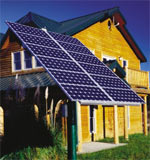Net Metering
Renewable Energy is a Vital Part of Ontario's Electricity Future.
 Ontario has opened the electricity market to
safe and clean renewable energy. Our net
metering regulation is designed to help you
participate in this clean energy future – and
to manage your energy costs.
Ontario has opened the electricity market to
safe and clean renewable energy. Our net
metering regulation is designed to help you
participate in this clean energy future – and
to manage your energy costs.
So, if you can generate any portion of your electricity needs through wind, water, solar or agricultural biomass, you need to know more about net metering in Ontario.
Generate Savings. Learn About Net Metering.
What is Net Metering?
Ontario's net metering regulation allows you to send electricity generated from renewable sources to the electrical grid for a credit toward your energy costs.
Here's how it works. Your utility will subtract the value of electricity you supply to the grid from the value of what you take from the grid. What you'll see on your bill is the "net" difference between those two amounts.
Net metering means you no longer need to purchase expensive batteries or a backup generator – or factor those costs into the price of installing a renewable energy generation system.
If you supply power that is worth more than what you take from the grid over the billing period, you'll receive a credit that can help lower future energy bills. The more electricity you produce, the greater your savings.
How Will My Bill Be Calculated?
 Your local utility will continue to read your
meter just as they do now. The bill you see
will reflect the difference between the value
of the energy you exported to the grid and
the value of the energy you needed to take
from the grid.
Your local utility will continue to read your
meter just as they do now. The bill you see
will reflect the difference between the value
of the energy you exported to the grid and
the value of the energy you needed to take
from the grid.
All of the regulated charges apply only to your net consumption. If that portion of your bill is zero, or a credit, your bill will include only your distributor's fixed monthly customer charge. And if you have more credit than you can apply to one bill you can carry the balance forward for up to one year to offset future costs.
Please note: To cancel a net metering agreement, all you need to do is provide your utility 90 days written notice.
Who is Eligible for Net Metering?
Net metering is available to any Ontario customer who generates electricity primarily for their own use from a renewable source (wind, water, solar or agricultural biomass), using equipment of maximum cumulative output up to 500 kilowatts in size.
I Want to Get Started. What's Next?
Net metering is a multi-step process that requires careful consideration. Here are the initial steps you'll need to undertake:
1. Find out more about the process.
The first step is to contact your local utility company. They can provide details about the technical requirements, the approval process, and how to obtain your net-metering agreement.
You may also want to contact Ontario's Electrical Safety Authority (ESA). They must inspect and approve your system. Along with your utility, the ESA is responsible for ensuring that your renewable energy system is properly connected to the electrical grid.
2. Investigate your renewable energy options.
Information is available from a range of sources, including renewable energy associations, consultants and vendors, as well as from some farm supply and hardware stores. A qualified supplier will be your key source of information about the most suitable option for you.
If you're in an urban setting, a solar array may work best since wind turbines may not be permitted given space requirements and local zoning bylaws. Wind and run-of-river water energy are options in rural locations. If you live on a farm, you may also be able to consider agricultural biomass.
Please be aware that to connect a hydro source, you may require additional approvals and permits from the Ministry of the Environment or Ministry of Natural Resources, depending on your location.
3. Determine what size system will suit your needs.
In order to size your system, identify your individual energy requirements. (The average Ontario home uses about 10,000-12,000 kWh annually.) You can use your previous bills as a starting point. It's also worth considering what energy requirements you can reduce through, for example, energy-efficient appliances and lighting.
Remember, your credits can only be carried forward for 12 months, so there is no value in over-sizing your system. And bear in mind, too, that the maximum production allowable is 500 kW. (Most residential generating systems produce between 1 and 4 kW of power.)
Get Your Tax Back.
Retail sales tax rebates are available for alternative energy systems installed in residential premises, if purchased between March 28, 2003, and November 25, 2007. This rebate applies to components, upgrades or expansions.
For more details, contact the Ministry of Finance, Retail Sales Tax Branch at 1-800-263-7965.
Learn more about net metering and how you can better manage your energy costs.
For More Information, Contact:
The Ontario Ministry of Energy
1-888-668-4636
Electrical Safety Authority
www.esainspection.net
1-877-372-7233



